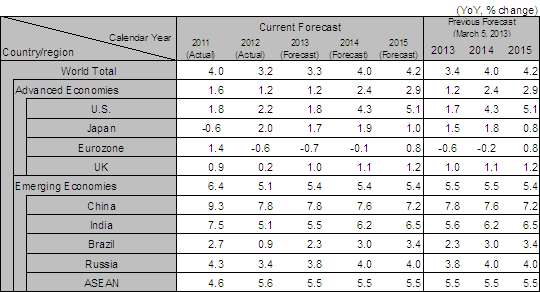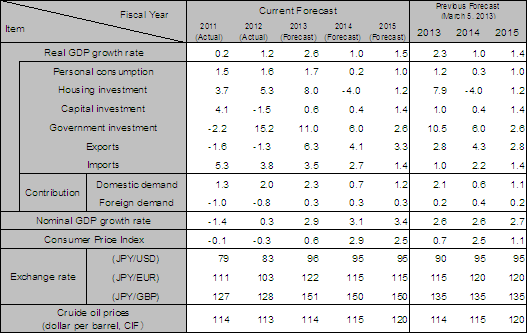Latest economic forecasts for Japan, the U.S., Europe, and China, etc
The global economy is gradually recovering. However, the differences between the economic situation in different countries have become more apparent.
In Japan and the U.S., where daring monetary easing has been implemented, some positive signs are evident. In the U.S., the disposal of bad bank loans was promptly carried out immediately following the financial crisis, and at the same time, the FRB eased credit using non-traditional methods. As a result, an adjustment of the excessive household debt progressed and the groundwork for growth has become established despite headwinds from a slightly tight fiscal policy such as sequestration. In Japan, an end to overvaluation of the yen and expectations for a departure from deflation brought about by “Abenomics” have lifted the spirits of the people.
On the other hand, in the eurozone, the disposal of bad bank loans became the responsibility of each respective country rather than the entire eurozone. As a result, peripheral countries that had fallen into sovereign debt crises have been unable to bail out their banks or dispose of bad loans. Therefore, the banking crisis continues. The ECB decreased the policy interest rate by 0.25% (from 0.75% to 0.5%) on May 2, 2013. However, the ECB cannot move toward further monetary easing because of inflation fears by Germany. Furthermore, fiscal consolidation has been imposed on every member country. As a consequence, fiscal austerity was implemented even in core countries such as Germany and effective demand across the entire eurozone was reduced. There has been some movement to relax fiscal tightening including the extension of deadlines to meet fiscal balance targets in peripheral countries. However, the policy to continue fiscal austerity throughout the entire eurozone remains unchanged at this point. In the U.K. as well, the Cameron administration is firmly maintaining its policy of fiscal austerity, as a result, the U.K. has yet to extract itself from the economic slowdown. In Europe, economic recovery following the financial crisis came to a halt in the summer of 2011, and the double-dip recession continues. It is highly possible that Europe has entered a 10-year plus period of stagnation similar to that of Japan in the 1990s and later.
In China and India, the start of the slowing economy was triggered by a stagnation of exports to Europe and funding pullbacks by European financial institutions, and via a stagnation of production and incomes, the situation is undergoing a change to economic slowdown due to a stagnation in domestic demand. The forecast is that it will take some time for the countries to move out of the current state. Even among Asian countries, countries and regions that are attempting export-driven growth are struggling while countries and regions with robust domestic demand such as Indonesia, Malaysia and the Philippines are performing relatively solidly.
The real GDP growth rate for the world economy for 2013 is forecast to be 3.3% which is 0.1% downwardly-revised from the previous forecast. The current gradual recovery will continue due to monetary easing by more and more countries. For the U.S., the real GDP growth rate for 2013 is estimated to be 1.8% which is 0.1% upwardly-revised from the previous forecast. Growth is expected to accelerate in the latter half of 2013 and later. For the eurozone, the forecast for the real GDP growth rate for 2013 is -0.7% and for 2014 the rate is -0.1%. There is no change in the forecast for the 3 years of consecutive negative growth from 2012. The real GDP growth rate for emerging economies is estimated to be 5.4% which is 0.1% downwardly-revised from the previous forecast. India’s real GDP growth rate is forecast to be 5.5% which is 0.1% downwardly-revised from the previous forecast, while 7.8% is estimated for China and 2.3% for Brazil. There is no change in the forecast for China and Brazil from the previous forecast.
The Japanese economy seems to have fallen into an economic slowdown since March 2012 but the economy bottomed out in November, and there is a perception that Japan has exited from economic slowdown. The real GDP growth rate for Japan from the January to March quarter of 2013 is high growth and 3.5%.
The “third arrow” of the “Abenomics” growth strategy is scheduled to be endorsed by the Cabinet on June 14, 2013. However, as far as the released outline goes, stimulus in a short period is not included. Basic Policies (Basic Policies for Economic and Fiscal Management and Reform) are also scheduled to be endorsed by the Cabinet in the middle of June. They are expected to set a goal of reducing the primary deficit to half in the 2015 fiscal year, which leads to the possibility that financial austerity may be implemented for immediate restoration of financial health in the 2014 fiscal year. This forecast is based on the premise that economic stimulus measures such as tax reductions for investment and public investment will be taken in order to cancel any downward pressure on the economy resulting from the consumption tax rate increase (from 5% to 8%) from April 2014. If this premise is incorrect, there is a risk of adverse effects on the economy in the 2014 fiscal year.
Japan’s real GDP growth rate for the 2013 fiscal year is estimated to be 2.6% which is 0.3% upwardly-revised. The exchange rates are forecast to hover around mainly at 95 yen/dollar, 120 yen/euro and 150 yen/pound. The Consumer Price Index for the 2015 fiscal year is forecast at 2.5% (1.8% excluding the influence of the consumption tax rate increase), and it is expected that the 2% inflation target will be nearly achieved in approximately 2 years.

Note: Since figures above are based on the calendar year, the figures for Japan are different from the fiscal-year based figures in the table below.
Source: IMF. Forecast by Hitachi Research Institute
